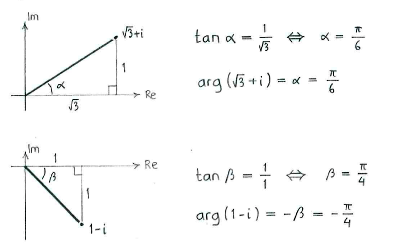Solution 3.2:5c
From Förberedande kurs i matematik 2
(Difference between revisions)
m (Robot: Automated text replacement (-[[Bild: +[[Image:)) |
m |
||
| (2 intermediate revisions not shown.) | |||
| Line 1: | Line 1: | ||
| - | {{ | + | Geometrically, the multiplication of two complex numbers means that there magnitudes are multiplied and their arguments are added. The product <math>(\sqrt{3}+i)(1-i)</math> therefore has an argument which is the sum of the argument for the <math>\sqrt{3}+i</math> and <math>1-i</math>, i.e. |
| - | < | + | |
| - | + | {{Displayed math||<math>\arg \bigl((\sqrt{3}+i)(1-i)\bigr) = \arg (\sqrt{3}+i) + \arg (1-i)\,\textrm{.}</math>}} | |
| - | {{ | + | |
| - | < | + | By drawing the factors in the complex plane, we can determine relatively easily the argument using simple trigonometry. |
| - | + | ||
[[Image:3_2_5_c.gif|center]] | [[Image:3_2_5_c.gif|center]] | ||
| + | |||
| + | (Because <math>1-i</math> lies in the fourth quadrant, the argument equals | ||
| + | <math>-\beta</math> and not <math>\beta</math>.) | ||
| + | |||
| + | Hence, | ||
| + | |||
| + | {{Displayed math||<math>\arg \bigl((\sqrt{3}+i)(1-i)\bigr) = \arg (\sqrt{3}+i) + \arg (1-i) = \frac{\pi}{6} - \frac{\pi}{4} = -\frac{\pi}{12}\,\textrm{.}</math>}} | ||
| + | |||
| + | |||
| + | Note: If you prefer to give the argument between <math>0</math> and <math>2\pi </math>, then the answer is | ||
| + | |||
| + | {{Displayed math||<math>-\frac{\pi}{12}+2\pi = \frac{-\pi+24\pi}{12} = \frac{23\pi}{12}\,\textrm{.}</math>}} | ||
Current revision
Geometrically, the multiplication of two complex numbers means that there magnitudes are multiplied and their arguments are added. The product \displaystyle (\sqrt{3}+i)(1-i) therefore has an argument which is the sum of the argument for the \displaystyle \sqrt{3}+i and \displaystyle 1-i, i.e.
| \displaystyle \arg \bigl((\sqrt{3}+i)(1-i)\bigr) = \arg (\sqrt{3}+i) + \arg (1-i)\,\textrm{.} |
By drawing the factors in the complex plane, we can determine relatively easily the argument using simple trigonometry.
(Because \displaystyle 1-i lies in the fourth quadrant, the argument equals \displaystyle -\beta and not \displaystyle \beta.)
Hence,
| \displaystyle \arg \bigl((\sqrt{3}+i)(1-i)\bigr) = \arg (\sqrt{3}+i) + \arg (1-i) = \frac{\pi}{6} - \frac{\pi}{4} = -\frac{\pi}{12}\,\textrm{.} |
Note: If you prefer to give the argument between \displaystyle 0 and \displaystyle 2\pi , then the answer is
| \displaystyle -\frac{\pi}{12}+2\pi = \frac{-\pi+24\pi}{12} = \frac{23\pi}{12}\,\textrm{.} |

